No product is as dependent on the weather as wild mushrooms. It’s impossible to guide the production, the harvest depends on what pickers find in the forests. Cep is a well-known mushroom, as are the yellow ochre chanterelles. Leon van Basten and Corné Verboom of Funghi Funghi talk about these mushrooms, but also shine a light on the more exclusive wood blewit, Finnish mini-shiitake and special mini-chestnut mushrooms.
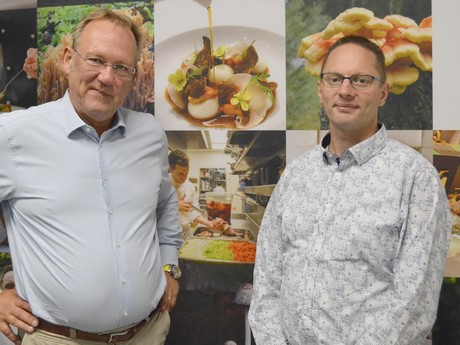
Leon van Basten and Corné Verboom of Funghi Funghi.
Five different mushroom varieties are lying on the table. The chanterelles are more distinctive in colour than the others. “I used to go picking chanterelles with my mother at the Veluwe, but they can hardly be found there nowadays,” Leon says. The valuable mushroom is now supplied by Eastern Europe, and is the best known of the exotic mushrooms. “They’re proper flavour bombs,” he describes the chanterelle.
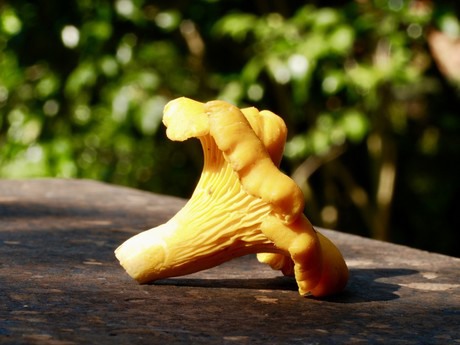 Perfect chanterelles
Perfect chanterelles
The supply of wild mushrooms has been delayed due to the dry weather throughout Europe in recent months. The lack of rain can also be seen in the mushrooms. “These chanterelles are a bit drier than normally,” Leon says while holding one of mushrooms. “But quality is good.” For chefs, the quality of the mushrooms has to be perfect. “Two or three chanterelles are often placed on plates in restaurants,” he continues. A damaged chanterelle harms the presentation, Leon knows. For a minute, the chef in him appears when he arranges three chanterelles in different ways on the table.
“In supermarkets, I sometimes see chanterelles from Poland or Serbia, but these aren’t the best quality,” Leon continues. Corné mentions the positive side of the increased availability of mushrooms. “The sector’s growing because of it, and it’s fun that we can contribute to that.” For the average consumer, knowledge of mushrooms could still be improved. Leon exemplifies: “Gastronomically speaking, a mushroom has more flavour if the cap is nicely opened, but consumers think those mushrooms have gone off. They still think it’s a bit scary. In Southern Europe, consumers pay more attention to flavour.”
To promote the category and inform consumers and chefs, each package has a QR code printed on it. This code leads directly to the company’s website, where a lot of information about the mushrooms can be found. “We want to grow into an authority in the field of mushrooms,” Leon says about the company’s ambition. Informing plays an important part in this. Besides the digital solution, a flyer with the different varieties printed on it will be handed out with each box of mushrooms in the coming weeks. Anything to make the products better-known. “I come from outside of the sector, and I’ve noticed relatively little is done with marketing,” Leon says. “A few prominent companies are working on this, but most of the products are anonymous. We can do much more by sharing knowledge.”
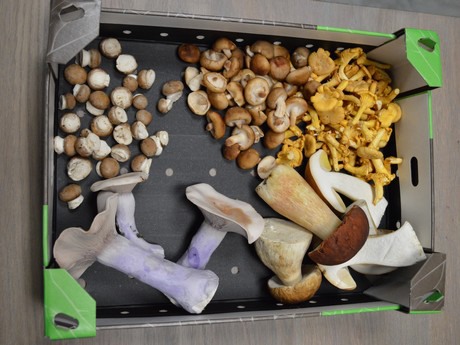
Impressive wood blewit
Leon carefully takes another mushroom from the box. “These are such wonderful products, but people know so little about them,” he says while admiring the wood blewit. The large mushroom with purple stem and light purple cap is standing proudly in the middle of the table. It looks impressive. “This mushroom has a special flavour with various notes of soil,” he continues. The mushroom is often used as decoration. Small point of attention: the wood blewit is slightly toxic, it’s necessary to heat it well to prevent stomach complaints.
Most chefs think these mushrooms are too large, they prefer the miniature version. “We buy these mushrooms from a grower in the marl quarry caves near Kanne on the Dutch border with Belgium,” says Corné. During the Second World War, the Germans decided to convert the old marl quarry caves into a factory for engines for the dreaded Messerschmitt fighter planes. Nowadays, these mushrooms, among others, are grown in the caves. The temperature in the caves is stable and the climate’s ideal.
The production of the mushrooms is shrouded in mysteries. Deep underground, where the temperature’s constant, no light penetrates, no sound can be heard and no wind can be felt, that’s where the wood blewit is grown. “They grow there in nursery trays, all standing up,” Leon explains. “But if you turn a corner into a different hallway, the mushrooms are suddenly facing right with their caps.” As if a trade wind’s blowing over the nursery trays, but there’s not a breath of wind in the caves. “It’s unexplainable,” he says.
Mushroom kitchen and clean product
“The production in the caves can’t be guided like in growth chambers,” Corné adds. After the harvest, this mushroom is placed in a box, and the workers take care the stems don’t touch. When the stems touch, they grow together. “This mushroom isn’t as well known in the Netherlands and Belgium, not even in gastronomy,” Corné continues. “The wood blewit is better known in the US, the UK and France.”
Another approach of Funghi Funghi to increase the familiarity of the mushrooms is in showing the mushrooms. For instance, in cooperation with a British customer, an open information evening is being organised, for which the complete assortment will be presented to a large number of chefs. Closer to home, an open information evening will be organised for Hotel School students in cooperation with a catering supplier. “The sooner they gain the knowledge, the better,” Leon says. “Chefs are looking for good products that have a story they can tell their guests.” Even closer to home, within their own walls, the company opened Funghi Kitchen. “We want to use this kitchen for demonstrations for our customers,” Leon says indicating a free-standing cooker in a corner of the spacious room. “We can’t stand the fact that users have so little knowledge of such a wonderful product.”
For chefs it’s important the products are supplied as cleanly as possible. In recent years, the number of people willing to work in kitchens has decreased, so products shouldn’t require too much work. “That’s why we’re working closely with our suppliers, and we instruct the pickers to supply the products as cleanly as possible,” Corné says. For the chanterelles, for example, hardly any earth can be on the stem upon arrival.
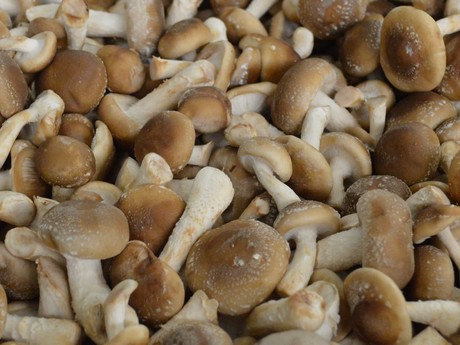
Mini-shiitake completely edible
The mini-shiitake fits this trend perfectly. This small version of the well-known shiitake has one major advantage: the stem can also be consumed. “They’re completely edible and completely clean,” Leon mentions the two advantages of this mushroom. “Ready-to-cook is becoming ever more important in catering.” The mini-shiitakes are imported from Finland. The small, brown mushroom is barely noticeable on the table. “Less meat is eaten all the time, and the mushroom is a good replacement,” Corné adds. In recent years, the market for mushrooms in general has reported good figures. “This trend will continue,” he expects. “Consumers want more and more choice in products.”
“You are in control of sustainability, that’s why we’re trying to pick that up wherever we can,” Corné continues. “We want to get rid of plastic packaging in the short term.” Packaging materials are becoming more and more sustainable. That’s why he’s hopeful this ambition can be realised. “It’s something we can do, and the market is headed in the right direction.”
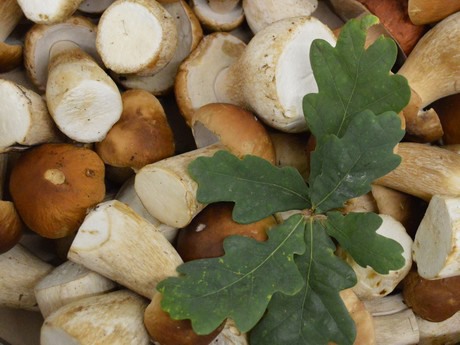
Sustainability is another theme for the supply of mushrooms. Mushrooms are a typical autumn product. Due to the season shifting all over the world, there’s always a country somewhere where chanterelles, for instance, can be picked, but the question is: should that be something we’d want? “The best chanterelles come from Scotland, but these are only available for a short period, and export volumes are too small,” Leon says. Scandinavia, the Baltic states and Eastern Europe supply first-class product during the season, but around Christmas, when the market peaks, no European supply can be found anywhere. “That’s when we import the chanterelles from the US and Canada, and cep from South Africa, but the best mushrooms come from woody regions in Europe,” Corné adds.
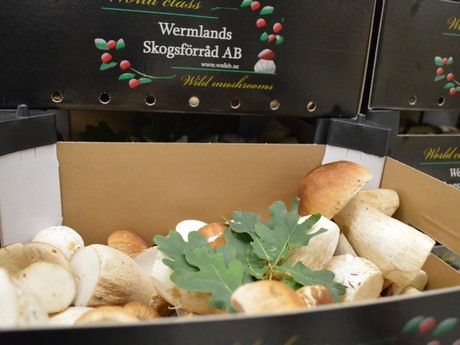
King mushroom: Cep
“This year, autumn hasn’t really started yet anywhere in Europe,” he continues. That can be seen in the supply of the wild mushrooms. The first Swedish cep only became available in the last week of August, some weeks later than usual. “This is the king among mushrooms,” Leon adds while taking a large mushroom with a firm light brown stem and large dark brown cap from the box. Cep and chanterelle are the two best-known wild mushrooms. A halved mushroom shows the inside of the cep: it’s even in colour with slightly yellow spores on the underside of the cap. “This mushroom is cut in half to check there are no worms in it, but that’s not the case this time,” Leon explains.
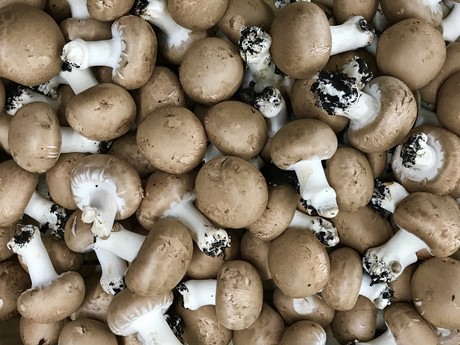 The least exotic mushroom in Leon and Corné’s selection is the mini-chestnut mushroom. This mushroom is exactly what its name says it is: a small version of the popular chestnut mushroom. Why do they want to shine a light on this mushroom? Corné answers: “We actually wanted to put the chestnut mushrooms from the caves in the spotlight, but these have been a bit delayed in production.” The chestnut mushroom from the nursery has a nuttier flavour than the white mushroom. However, the mushrooms from the caves have an even finer flavour. These mushrooms grow more slowly because the climate in the caves can’t be adjusted. “These mushrooms needed more time and rest. That results in a small, firm mushroom with a high dry dust content, and less moisture means more flavour and a better bite.”
The least exotic mushroom in Leon and Corné’s selection is the mini-chestnut mushroom. This mushroom is exactly what its name says it is: a small version of the popular chestnut mushroom. Why do they want to shine a light on this mushroom? Corné answers: “We actually wanted to put the chestnut mushrooms from the caves in the spotlight, but these have been a bit delayed in production.” The chestnut mushroom from the nursery has a nuttier flavour than the white mushroom. However, the mushrooms from the caves have an even finer flavour. These mushrooms grow more slowly because the climate in the caves can’t be adjusted. “These mushrooms needed more time and rest. That results in a small, firm mushroom with a high dry dust content, and less moisture means more flavour and a better bite.”
More information:
Funghi Funghi
Leon van Basten
Corné Verboom
corne@funghifunghi.com
www.funghifunghi.com
